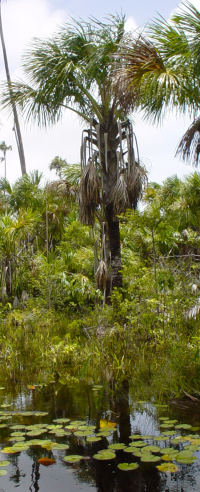Muriti
|
Mauritia flexuosa Moriche palm |
|
|---|---|
 |
|
| Moriche palm in Marajó | |
| Scientific classification | |
| Kingdom: | Plantae |
| (unranked): | Angiosperms |
| (unranked): | Monocots |
| (unranked): | Commelinids |
| Order: | Arecales |
| Family: | Arecaceae |
| Genus: | Mauritia |
| Species: | M. flexuosa |
| Binomial name | |
|
Mauritia flexuosa L.f. |
|
| Synonyms | |
|
|
Mauritia flexuosa, known as the moriche palm, ité palm, ita, buriti, muriti, canangucho (Colombia), or aguaje (Peru), is a palm tree. It grows in and near swamps and other wet areas in tropical South America. It has been reported from Trinidad, Colombia, Venezuela, Guyana, Suriname, French Guiana, Brazil, Ecuador, Peru, and Bolivia.
M. flexuosa, a tree, can reach up to 35 m (115 ft) in height. The large leaves form a rounded crown. The flowers are yellowish and appear from December to April. The fruit, which grows from December to June, is a chestnut color and is covered with shiny scales. The yellow flesh covers a hard, oval nut. The seeds float, and this is the means by which the palm tree propagates. In natural populations, the tree reaches very high densities.
Moriche palm fruit is edible and used to make juice, jam, ice cream, a fermented "wine", desserts and snacks, requiring harvesting of more than 50 tonnes per day in Peru.
The inflorescence buds are eaten as a vegetable and the sap can be drunk fresh or fermented (see palm wine). Threads and cords are locally produced from the tree's fibers.
Humans consume palm weevils which burrow in the tree trunk.
Buriti oil is an orange-reddish oil extracted from the fruit of the moriche palm. The oil contains high concentrations of oleic acid, , and carotenoids, especially beta-carotene. The oil has a reddish color used as ink on hides and skins.
...
Wikipedia
